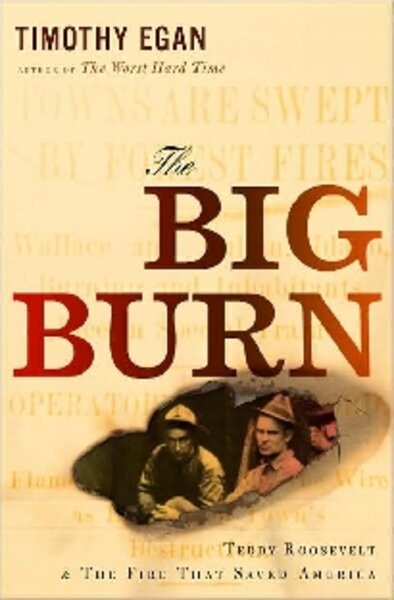The Big Burn
Loading...
In an author’s note at the opening of The Big Burn: Teddy Roosevelt and the Fire That Saved America, Timothy Egan describes his major goal as a writer. “[Y]ou try to answer the timeless question: Do you know any good stories?” Egan, who won a National Book Award for “The Worst Hard Time,” a social history of the Depression-era Dust Bowl in Oklahoma, has already proved himself to be a masterly collector of memorable stories.
His new book, “The Big Burn,” continues in the same tradition. It is also a clarion call for the conservation philosophies of John Muir and others as Egan details the saga of “the largest wildfire in American history.”
This fire was, for a month, a collection of some 3,000 separate fires. But with the impetus of a palouser, a form of intense wind created by the very geography of the Northwest, these fires converged into one and then burned ferociously for two days in August 1910, ultimately destroying 3 million acres of forest in the states of Washington, Idaho, and Montana.
The flames, pushed along by what grew to become hurricane-force winds, spread throughout the drought-stricken forests of the Bitterroot Mountains. They became a blaze that seriously affected five towns and took the lives of 85 of the 10,000 firefighters who fought it.
But what makes “The Big Burn” particularly impressive is Egan’s skill as an equal-opportunity storyteller. By this I mean that he recounts the stories of men and women completely unknown to most of us with the same fervor he uses to report the stories of historic figures.
I left this book with a new fascination for Gifford Pinchot, founder of the National Forest Service, and his colleague, Theodore Roosevelt. At the time of the fire, Roosevelt was no longer president. The only authority he then possessed was moral authority. But while president, he had put 180 million acres of Northwest Forest land into a national forest. And together with Pinchot, he created the National Forest Service to oversee it.
No less fascinating than the stories of Pinchot and Roosevelt, however, are those of the first forest rangers (dubbed “Teddy’s Green Rangers”): Ed Pulaski, Bill Greely, and Bill Weigle – and their families.
Are there villains? Why, of course. There are “the Gilded Age Plutocrats,” led by William Howard Taft. These men do yeomanlike battle with Roosevelt, Pinchot, and the National Forest Service for control of what they view as land rich in moneymaking opportunities.
Particularly fascinating is the struggle between Roosevelt and Taft. “Despite his girth, William H. Taft was always the smaller man when in Roosevelt’s presence, or so he felt. Roosevelt was like a human volcano, Taft was a putting green.... Roosevelt burned 2,000 calories before noon and drank his coffee with seven lumps of sugar; Taft was the picture of sloth; multiple chins, a zest for five-course meals and long baths.”
Structurally, the book is a drama in three acts. The first introduces us to the major characters and the geography. The second, and longest, is a detailed re-creation of the struggle against the firestorm.
The detail here is often overwhelming. But readers will be well rewarded by the third and most moving section – a collection of heartbreaking stories describing the full impact of the fire, both on the lives of the people described in the book and on the land itself.
Egan also details the policy debates that were raging in 1910, most of which remain current today. Should fires be fought at all costs – or are they part of nature’s greater plan and to be managed in a very controlled approach? Are forests the legacy that one generation of Americans passes on to another – or are they sources of minerals and timber necessary for economic development?
Even as we mark the centennial of this great fire, wildfires in the West continue to burn. It makes this book – which is a masterwork in every sense – worthy of a very careful reading.






